 |
| Jerpoint Abbey |
 |
| Blarney Castle |
 |
| Cliffs of Moher |
Tammy and I spent 3 weeks in Ireland in June. After arriving in Dublin we headed south to Kilkenny, then followed the coast clockwise around the island, finally ending in Dublin. We loved everywhere we visited in Ireland, and the people were so warm and welcoming. I've broken this into three blog posts: Republic of Ireland, Northern Ireland, and Dublin.
 |
| Kilkenny Cathedral |
 |
| Gate in Kilkenny wall |
 |
| Kilkenny Castle |
Kilkenny is a beautiful town with lots of history and great streets to wander. The Anglo-Norman Kilkenny Castle was built in the late twelfth century. The parallel streets of High Street and St Kierans’s make up the Medieval Mile. Black Abbey is celebrating its 800th anniversary. Walk down the nave and turn right for stunning stained-glass windows depicting the life of Jesus.
St. Canice’s Cathedral was built in the late twelfth century by the Anglo-Norman conqueror Strongbow. The Round Tower, the oldest structure in Kilkenny dating from 1111, is one of only two in Ireland open to climb, and we ascended the 120 steps for an amazing view of Kilkenny.
 |
| Black Abbey stained glass |
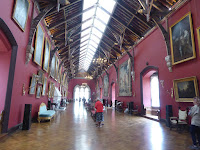 |
| Kilkenny Castle hall |
 |
| High Street |
The Left Bank restaurant has great atmosphere and good food. We enjoyed both Kyteler's Bar [link] and Petronella Restaurant, which has an interesting story. Alice Kyteler had four husbands, and killed all of them, amassing a fortune. She was accused of witchcraft by the children of her fourth husband. She was sentenced to be burned at the stake for being a witch in 1324, the first such execution in the British Isles. The night before her execution, she disappeared, never to be seen again. In her place, the authorities burned her housemaid Petronella instead.
The Smithwick's Experience was an interesting brewery tour, and not overly commercialized like Guinness or Heineken. While the Smithwick’s ale is good, I prefer Kilkenny Beer.
 |
| Hole in the Wall |
The Hole in the Wall pub dates from the early 16th century. The proprietor Mike Conway is a cardiologist who runs the pub in his spare time. We were fortunate to be the only two patrons, and spent an hour talking to him; this was definitely a highlight of the trip. Great music at the Hibernian Bar and The Field, and we enjoyed drinks at Cleere's.
Sites north of Kilkenny
 |
| Sally Gap |
 |
| Sally Gap |
Heading south from Dublin toward Kilkenny, we drove the R-115 and R-759 through the Wicklow Mountains, which is an incredibly beautiful drive through rustic scenery. The Sally Gap is especially beautiful, with incredible mountain vistas. Arriving in Glendalough (glen dah lock), we visited the monastic settlement founded in the sixth century by St Kevin. There is an informative movie and museum in the visitor’s center. Walk through the gate into the medieval settlement. The twelfth-century ruins of the cathedral and priest’s house are surrounded by Celtic crosses marking graves of the monks, with St. Kevin’s Cross being the most noteworthy. The Round Tower design is unique to Ireland, and Glendalough has a well-preserved example.
 |
| Glendalough chapel |
 |
| Celtic cross and round tower |
 |
| Glendalough entrance |
Rock of Cashel is amazing, high on the crest of a hill overlooking the plains of Tipperary. St Patrick baptized St Aengus here in 450. Cormac’s Chapel was built in 1134, and the adjoining Cathedral was built one hundred years later. The round tower, a design unique to Ireland, dates from the twelfth century.
 |
| Cashel chapel |
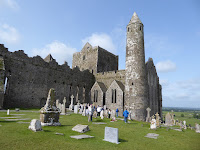 |
| Cormac's Chapel and round tower |
 |
| Rock of Cashel |
Sites south of Kilkenny
There are numerous sites dating from the Norman conquest in the late twelfth century (a century after the Norman conquest of England).
Kells Priory is a massive monastic site, with three acres contained within a wall with six towers. Walking the ruins was a great experience, the isolated site is very tranquil, all you hear is the “maaah” of the sheep.
 |
| Kells Priory |
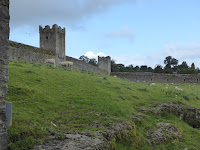 |
| Inside Kells Priory |
 |
| Kells Priory tower |
Jerpoint Abbey, established in 1180, is perhaps the finest abbey ruins in Ireland, highly recommended. It’s critical to take a free guided tour, our guide really brought the site to life. The columns of the cloister have unique carvings of religious figures and benefactors, and two tombs have ornate carvings of saints and the apostles.
 |
| Jerpoint cloister carvings |
 |
| Jerpoint Abbey |
 |
| Jerpoint Abbey cloister |
 |
| Dunbrody Famine Ship |
The Dunbrody Famine Ship is an immersive experience that depicts the plight of the impoverished Irish people during the famine of 1845-49, and the harrowing journey they took to America. The ship, and the guide who describe the ordeal, explains the horrific conditions on the 4-8 week journey. Across from the Dunbrody Famine Ship is the exhibit of the contemporary Ros Tapestries, which document in 15 tapestries the Norman History of Ireland. The audio tour gave a good overview of this pivotal period.
Waterford
Waterford is Ireland’s oldest city, from tenth century Viking “Reginald’s Tower” to Norman structures from the twelve century. In 1167 Dermot MacMurrough was deposed as king of Leinster (eastern Ireland), and solicited the Normans in England to help him regain power. Their victory, and the Norman Strongbow’s marriage to Dermot’s daughter Aiefe, began centuries of Norman rule in Ireland. Their marriage took place at Waterford‘s Christ Church Cathedral. This story is depicted in the Ros Tapestries mentioned above.
 |
| Reginald's Tower and Viking ship |
 |
| Christ Church Cathedral |
 |
| Cathedral, Strongbow and Aiefe |
We bought the Freedom of Waterford Pass (WaterfordTreasures.com) pass, which gave us access to all the key museums. We explored the Museum Quarter and Barronstrand pedestrian street. The Epic Walking Tour hosted by Waterford Treasures was excellent, 1000 years of history with an entertaining guide. The Medieval Museum was very well curated, describing Waterford history from Viking age (tenth century) until the devastation of Oliver Cromwell in the seventeenth century. The Museum of Time was very interesting, with timepieces from the past 300+ years. The Bishop’s Palace museum presents Waterford history after 1700. It was relatively interesting, the highlight was the description of the life of Thomas Francis Meagher (pronounced “Mahr”). Meagher was involved in the failed 1848 rebellion, exiled to Tasmania for his involvement, escaped to New York and started an Irish newspaper, fought as a Brigadier General in the American Civil War, and eventually became governor of Montana Territory!
The Waterford Crystal factory tour far exceeded expectations, and was one of the highlights of the trip. Seeing the artisans cutting the intricate patterns into crystal by hand was incredible, and explains the high cost of their glassware. See videos of the molten glass shaping and crystal cutting. The Café is a great place to eat, we enjoyed scones and coffee were great.
Dinner at Emiliano’s Restaurant was excellent, we felt like we were in Italy.
Kinsale
Kinsale was a major port for Ireland, and home to a Spanish Armada protecting the wine trade through Kinsale. We started our visit with the excellent Walking tour with Barry Moloney (www.historicstrollkinsale.com), equally entertaining and informative. In addition to covering the town sites, Barry vividly explained the Battle of Kinsale (1601), where English troops surrounded and defeated Irish and Spanish troops, thus securing English control of Ireland. He linked this pivotal English victory to future Irish rebellions, civil war, Irish migration (especially to America), and the Troubles of the twentieth century.
 |
| Kinsale street |
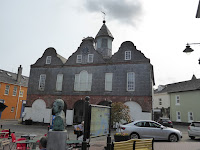 |
| Kinsale City Hall |
 |
| Kinsale street |
Kinsale is a beautiful little town surrounding a harbor that has filled with silt, no longer a major port, but a sleepy fishing village. With twelve-foot tides, sailboats are often stranded in the harbor. The town is great to explore, and we walked out to Charles Fort, with a view of James Fort; the two forts protecting the once-strategic harbor. On the way, the Spanish Inn is a nice pub and The Bulman Bar is a great place to eat.
 |
| The Greyhound |
 |
| Boats stranded at high tide |
Fishy Fishy was great for lunch, and the Black Pig serves innovative tapas. The Greyhound Pub has great atmosphere.
On the way to Kinsale we visited the Blarney Castle and Gardens. Despite its reputation as a tourist trap, we really enjoying climbing the castle ruins, and wandering through the gardens.
Kenmare
Kenmare is a small town with not much going on, but it’s right at the start of the amazing Ring of Kerry drive. There is a small but interesting museum in the TI, the Holy Cross Church is worth a look. An ancient Stone Circle is near the town center, it’s more than 3000 years old, with 15 stones probably used as a celestial calendar. We had dinner at The Lime Tree, excellent food in an 1850 carriage house on the former estate of William Petty Fitzmaurice, the Marquis of Lansdowne who, as British PM, negotiated the 1783 Treaty of Paris ending the American War of Independence from Britain.
 |
| Kenmare Cathedral |
 |
| Kenmare Cathedral |
 |
| Stone Circle |
 |
| Killarney National Park |
 |
| Killarney |
 |
| Killarney |
On the drive to Kenmore we stopped in Killarney for breakfast. The town has a reputation as overly-touristed since many Ring of Kerry tours leave from here, but we thought it was a cute town.
Muckross House is an immense and beautifully maintained Victorian mansion from 1843, located in Killarney National Park. It’s a unique view into how Victorian aristocracy lived. Nearby, the Torc Waterfall is beautiful. Before arriving in Kenmare, we visited the Kissane Sheep Farm [see videos here, here, and here], which provided a fascinating demonstration of sheep dogs herding sheep, it was really amazing.
Ring of Kerry
It’s advisable to drive clockwise on the Ring, as buses drive counter-clockwise and leave Killarney/Kenmare at 10:30. We left early to avoid buses and didn’t see any until the end of the Ring, so most of the sites were not crowded when we arrived.
The Staigue ring fort is among the best preserved in Ireland, it’s 2000 years old and constructed of flat stones. Castle Cove, the Coomakesta Pass, River Inny and the Minard Castle ruins all provided beautiful vistas. The Kerry Cliffs were stunning, I think more impressive than the more famous Cliffs of Moher. Skellig Chocolate Factory is a nice stop along the way.
 |
| Kerry Cliffs |
 |
| Kerry Cliffs |
 |
| Kerry Cliffs |
 |
| Kerry Cliffs |
 |
| View of Skellig Michael |
 |
| Coomakesta |
Dingle
Dingle Town is a quintessential Irish town, and has perhaps the best Irish music scene in the country. Every bar has live music, and you can just walk down the street and pop in to listen. The town is made up of four streets making up a square, plus the waterfront area. We stayed at the Base Dingle, which was a great modern hotel in a great location, with historic O’Flaherty’s Pub next door.
 |
| Making belts at Dick Mack's |
 |
| Main Street Dingle |
 |
| Foxy John's Hardware |
Dingle is known for its music, and we tried to hit all the famous places. Dingle Pub, Dick Mack's and Ashe Bar all have great atmosphere and good bands. At Curran’s Pub we met the owner James Curran, whose grandmother ran a general store in the front room that is now the pub. Kennedy’s is tiny, with a 10x10 room crowded with patrons listening to Tanglewood (similar to bluegrass, see video here).
Our favorite was Foxy John’s Hardware Bar , which has a shop in the front and bar in the rear, which is common in Dingle (and we saw a few examples elsewhere in Ireland). The band at Foxy Johns was excellent [video here].
 |
| Harry Clarke windows |
Behind St Mary's Church in the convent are amazing stained-glass windows from Ireland's famed Harry Clarke. We had an excellent seafood dinner at Out of the Blue, and tried Murphy’s Ice Cream which began in Dingle as is now everywhere in Ireland.
Dingle has its own distillery [link] making good Gins and Whiskeys.
The western Dingle Peninsula is called Slea Head and is the western extreme of Ireland (and Europe). The drive is incredibly scenic and the views are amazing. In addition to incredible views of Dingle Bay and the Atlantic Ocean, we also saw beehive houses, views of Blasket Islands, Reasc Monastery ruins, Gallarus Oratory, and Kilmalkedar Church. The Blasket Centre provides a very interesting history of the lives of the roughly 100 people who lived on this rocky island until they were forced to evacuate in 1953 - it’s surprisingly engaging.
 |
| Slea Head |
 |
| Slea Head |
 |
| Minard Castle |
Cliffs of Moher and The Burren (County Clare)
Leaving Dingle for Galway, we visited the Cliffs of Moher, which are incredible. Several “cliff headlands” jut into the Atlantic, two can be visited and provide amazing views. We had excellent weather, so the visibility was great.
 |
| Cliffs of Moher |
 |
| Cliffs of Moher |
 |
| Cliff of Moher |
Heading inland, we drove through The Burren, which is a stark and barren limestone plateau with beautiful vistas. The famous Poulnabrone Dolen, a 5000 year old tomb, is impressive. At the end of the drive (after leaving the Burren and returning to lush green landscape), Dunguaire Castle is an incredible image.
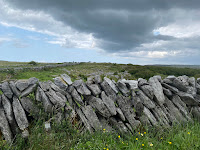 |
| Burren stone fence |
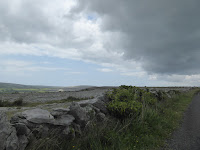 |
Burren rocky terrain,
lush green landscape in distance |
 |
| Dolmen |
Galway
Galway is an ancient city, the Normans capturing it in 1234, building a wall around the town in 1270 (the “Spanish Gate” is a portion that still remains). The Latin Quarter was once contained with the city walls, and has a medieval labyrinth of streets, with lots of pubs providing live music. The City Museum is interesting, as is the Collegiate Church of St. Nicholas (built in 1320). We visited on a Saturday so got to experience the street market around the church.
 |
| King's Head |
 |
| High Street |
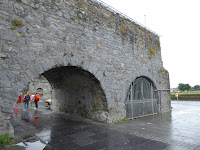 |
| Spanish Arch |
In the new town, all streets emanate from Eyre Square. Our hotel, the Hardiman, was on the square, as are several pubs and restaurants. Galway Cathedral is quite impressive, completed in 1965 it is one of the last great stone churches built in Europe. Charlie Byrne’s bookstore is the best we visited in Ireland. We walked to the seaside neighborhood of Salthill, which was kind of depressing (perhaps because it was cold and rainy that day).
 |
| O'Connor's Salthill |
 |
| Lynch Castle |
 |
| Shop Street |
We had an excellent meal at Ruibin. The King’s Head [link] was opened around 1649 by the executioner who beheaded King Charles I of England, who fled London and sought refuge in far away Galway, definitely worth a visit.
Connemara (County Galway) and County Mayo
Leaving Galway we visited the tiny village of Cong, and the ruins of the Cong Abbey. We would later see the Cross of Cong, which reputedly one contained a sliver of Jesus’ cross, in Dublin’s National Museum of Anthropology. The drive through Connemara National Park is beautiful, driving along Killary Fjord (famous for its mussels) and Kylemore Abbey.
 |
| Cong Abbey |
 |
| Cong Church |
 |
| Killary Fjord |
 |
| Doo Loch cross |
Entering County Mayo, the views of Doo Lough are amazing, where a cross commemorates the tragic 1849 death of over 200 starving people during the Great Famine, who marched fifty miles in search of food (and were turned away). Entering the town of Murrisk, Crough Patrick rises 2500 feet. It is the mountain on which St Patrick rang his bell, driving all the snakes from Ireland around 450 AD. Nearby is a sculpture depicting a “Famine Ship”, many of which took the starving Irish to North America in hellish conditions, in search of a better life.
Westport is the most picture-perfect Irish town we visited. It’s very small, but charming, having been built as a planned community in the late 1700s to support the nearby estate of English Lord Browne. Westport has a vibrant music scene, we enjoyed listening to Irish “trad” (traditional) music at Matt Molloy’s (see video here), whose owner played flute for the Chieftains. At JJ O’Malley's we had a great meal and enjoyed their trad music. While in Westport, I enjoyed Grace O’Malley Whiskey, named after the seventeenth century pirate queen.
 |
| Westport clock tower |
 |
| Matt Molloy's |
 |
| Bridge Street |
 |
| Octagon |
 |
| Peter Street |
 |
| Octagon |
County Donegal
Leaving Westport, we headed for the town of Donegal, which didn’t have a lot to offer other than a great castle right off the main square. The real attraction of County Donegal is the drive through Glenveagh National Park and along the Atlantic coast. Our first stop was Newmills Corn and Flax mills, which was a fascinating view into the operations of a flax mill, and also a grain mill (Irish referred to oats and other grains as “corn”, not to be confused with maize). Both were restored and operating, and the tour was very interesting. The process of turning flax into thread is amazing. See videos: Newmills, water wheel, grain sifting, milling.
 |
| Aileach Ring Fort |
 |
| Newmills |
 |
| Donegal town |
The drive through Glenveagh National Park was beautiful. Glenveagh Castle is stunning, sitting on the edge of a long lake (similar to a Scottish loch). The Bloody Foreland offers an incredible vista. The Dunfanaghy Workhouse was an interesting look into the harsh existence of starving peasants who were housed at workhouses across Ireland during the Great Famine. Before reaching Northern Ireland, we visited Grianan of Aileach Ring Fort. The difficult drive uphill on one lane (but two-way traffic) roads justified the view, but had we know it was reconstructed in the 1800s, we might have skipped it.
 |
| Bloody Foreland |
 |
| Bloody Foreland |
 |
| Glenveigh Castle |
 |
| Aileach Ring Fort |
 |
| View from Aileach |




















































































No comments:
Post a Comment